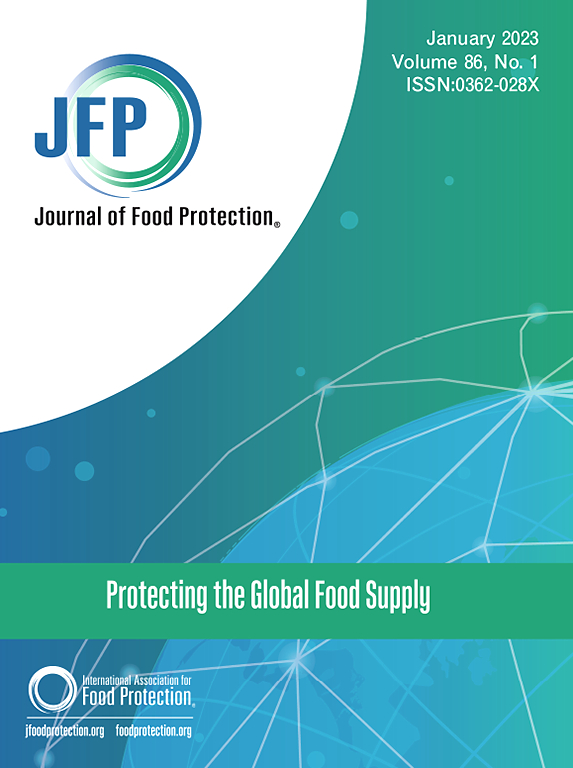Informative Value of a Sample Investigation with a Predefined Sample Size using the Example of Listeria monocytogenes in Food Safety
IF 2.1
4区 农林科学
Q3 BIOTECHNOLOGY & APPLIED MICROBIOLOGY
引用次数: 0
Abstract
Foodborne diseases, especially those caused by zoonotic agents, pose a significant threat to human health. Food business operators are therefore responsible for producing safe food. To do this, they must regularly carry out appropriate sample investigations to detect zoonotic agents in their food before it leaves the factory. Depending on the issue investigated, there may be legal requirements for food business operators, usually specifying minimum sample sizes, such as Commission Regulation (EU) No 2073/2005. However, in most cases, there is no information on the precision, and therefore, on the significance of the results for these sample sizes.
Regulatory veterinary authorities have a control function and, as a result, they are required to regularly evaluate the available investigations and their results. In addition, in certain crisis situations (e.g., foodborne outbreaks or suspected food contamination), authorities may guide food business operators in their investigations and conduct their own investigations to assess food safety measures. In such cases, as there are no legally defined sample sizes to be taken, the appropriate sample sizes must be determined by the authorities. This can lead to a conflict between the need for feasibility and the need for conclusiveness of the investigation potentially being a challenge for the regulatory authority in charge.
This paper highlights the importance of thoughtful study design and the critical communication of available results by veterinary authorities on the background of a use case involving Listeria monocytogenes findings in a crisis situation. Using the minimum sample size, n = 5, required by Commission Regulation (EU) No 2073/2005 for the pathogen Listeria monocytogenes as a guide, the uncertainties associated with small sample sizes are highlighted. It also aims to facilitate the evaluation of studies performed and the assessment of further sample sizes.
以食品安全中的单核细胞增生李斯特菌为例,预设样本量的抽样调查的信息价值。
食源性疾病,尤其是由人畜共患病引起的疾病,对人类健康构成重大威胁。因此,食品企业经营者有责任生产安全的食品。为此,他们必须定期进行适当的抽样调查,以便在食品出厂前检测出食品中的人畜共患病病原体。根据所调查的问题,法律可能会对食品企业经营者提出要求,通常会规定最低样本量,如欧盟委员会第 2073/2005 号条例(Commission Regulation (EU) No 2073/2005)。然而,在大多数情况下,并没有关于这些样本量的精确度以及结果重要性的信息。兽医监管机构具有控制职能,因此需要定期评估现有的调查及其结果。此外,在某些危机情况下(如食源性疾病爆发或疑似食品污染),当局可能会指导食品企业经营者开展调查,并自行开展调查以评估食品安全措施。在这种情况下,由于法律上没有规定必须抽取的样本量,因此适当的样本量必须由当局确定。这可能会导致调查的可行性需求与结论性需求之间的冲突,对负责监管的当局来说可能是一个挑战。本文以在危机情况下发现李斯特菌的使用案例为背景,强调了兽医当局进行周密的研究设计和对现有结果进行重要沟通的重要性。本文以(欧盟)第 2073/2005 号法规规定的单核细胞增生李斯特菌病原体最小样本量(n=5)为指导,强调了与小样本量相关的不确定性。它还旨在促进对已开展研究的评估和对进一步样本量的评估。
本文章由计算机程序翻译,如有差异,请以英文原文为准。
求助全文
约1分钟内获得全文
求助全文
来源期刊

Journal of food protection
工程技术-生物工程与应用微生物
CiteScore
4.20
自引率
5.00%
发文量
296
审稿时长
2.5 months
期刊介绍:
The Journal of Food Protection® (JFP) is an international, monthly scientific journal in the English language published by the International Association for Food Protection (IAFP). JFP publishes research and review articles on all aspects of food protection and safety. Major emphases of JFP are placed on studies dealing with:
Tracking, detecting (including traditional, molecular, and real-time), inactivating, and controlling food-related hazards, including microorganisms (including antibiotic resistance), microbial (mycotoxins, seafood toxins) and non-microbial toxins (heavy metals, pesticides, veterinary drug residues, migrants from food packaging, and processing contaminants), allergens and pests (insects, rodents) in human food, pet food and animal feed throughout the food chain;
Microbiological food quality and traditional/novel methods to assay microbiological food quality;
Prevention of food-related hazards and food spoilage through food preservatives and thermal/non-thermal processes, including process validation;
Food fermentations and food-related probiotics;
Safe food handling practices during pre-harvest, harvest, post-harvest, distribution and consumption, including food safety education for retailers, foodservice, and consumers;
Risk assessments for food-related hazards;
Economic impact of food-related hazards, foodborne illness, food loss, food spoilage, and adulterated foods;
Food fraud, food authentication, food defense, and foodborne disease outbreak investigations.
 求助内容:
求助内容: 应助结果提醒方式:
应助结果提醒方式:


